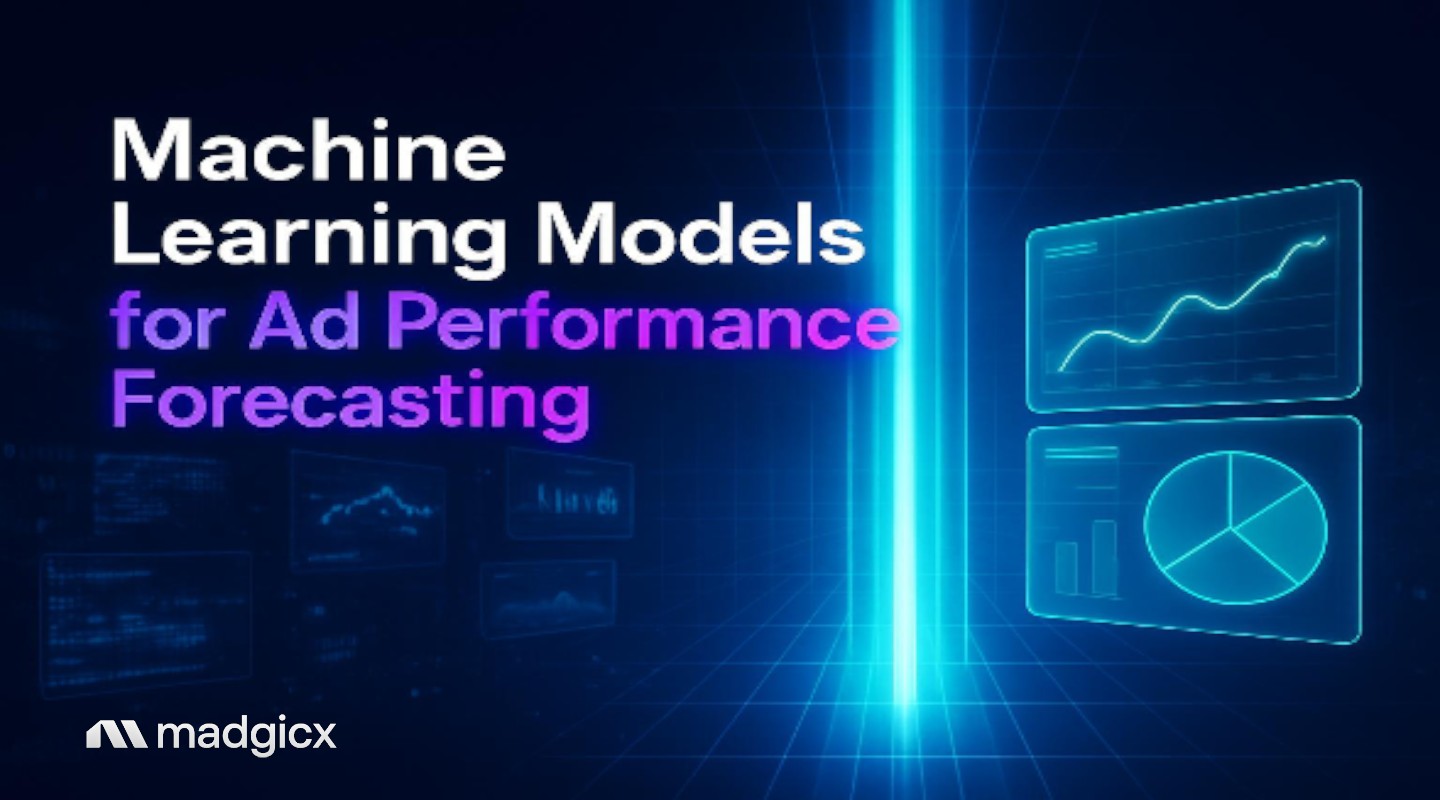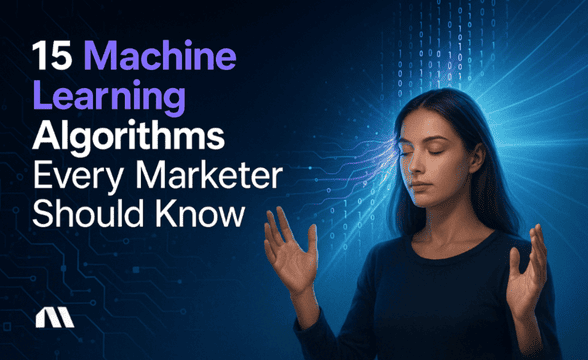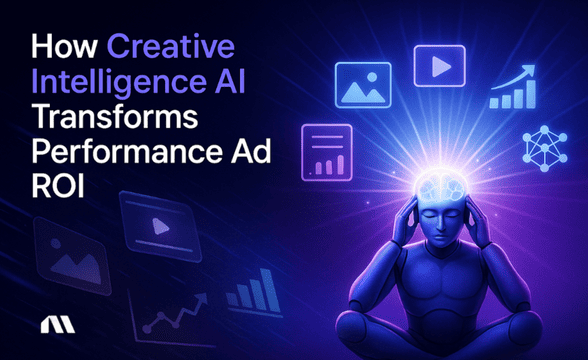Learn how to implement machine learning models for ad performance forecasting. Complete guide covering XGBoost, ARIMA, and LSTM with real ROI data and setup.URL
Picture this: You're staring at your campaign dashboard at 2 AM, trying to predict which ads will perform tomorrow. Your gut says one thing, but last week's "sure winner" crashed and burned, leaving you with a blown budget and some awkward client conversations.
Sound familiar? Here's the thing – you don't have to rely on guesswork anymore.
Machine learning models for ad performance forecasting can deliver significantly improved accuracy compared to traditional methods, helping reduce forecasting errors in many implementations. The most effective models include XGBoost for structured data analysis, ARIMA for time series patterns, and LSTM networks for complex sequential dependencies.
This guide breaks down the top ML models, shows you exactly how to implement them, and reveals which approach works best for different advertising scenarios. By the end, you'll know exactly which model to use for your campaigns and how to set it up properly.
What You'll Learn in This Guide
We're covering everything you need to transform your advertising forecasting from reactive to predictive:
- Which ML models deliver strong forecasting accuracy for different ad types
- Step-by-step implementation guides for XGBoost, ARIMA, and LSTM models
- Privacy-compliant forecasting methods that work in the iOS 14.5+ era
- Real performance benchmarks and ROI data from successful implementations
- How to combine multiple models for improved prediction accuracy
Understanding Machine Learning in Ad Forecasting
Let's start with the basics. Traditional ad forecasting relies on historical averages, seasonal patterns, and a lot of educated guessing. It's like trying to predict the weather by looking out your window – sometimes you're right, but you're often caught in the rain.
Machine learning models for ad performance forecasting analyze thousands of variables simultaneously: audience behavior patterns, creative performance history, competitive landscape changes, seasonal trends, and even external factors like economic indicators. It's like having a meteorologist with access to satellite data, weather stations, and atmospheric models.
The results speak for themselves. According to recent industry studies, ML campaigns can deliver 14% higher conversion rates compared to traditional forecasting methods. More importantly for your bottom line, AI can help reduce customer acquisition costs in many implementations when applied correctly.
Privacy Compliance in the Modern Era
Here's where things get interesting. The iOS 14.5+ privacy updates didn't just change tracking – they fundamentally altered how we need to approach forecasting.
Traditional models that relied heavily on third-party data and pixel tracking are now operating with incomplete information. Modern machine learning models for ad performance forecasting address this by focusing on first-party data patterns, server-side tracking integration, and predictive budget allocation strategies that work within privacy constraints.
This shift actually makes forecasting more robust, not weaker.
Time Series Forecasting Models
Time series models are your bread and butter for advertising forecasting. They excel at identifying patterns over time and predicting future performance based on historical trends.
ARIMA (AutoRegressive Integrated Moving Average)
ARIMA is like the reliable friend who always shows up on time. It's particularly effective for campaigns with clear seasonal patterns or consistent trends.
Best Use Cases:
- Seasonal e-commerce campaigns (holiday shopping, back-to-school)
- Brand awareness campaigns with consistent spend
- Long-running campaigns with stable audience targeting
Implementation Steps:
- Data Preparation: Collect at least 30 days of campaign data (daily metrics work best)
- Stationarity Testing: Use the Augmented Dickey-Fuller test to check if your data is stationary
- Parameter Selection: Determine optimal p, d, and q values using autocorrelation plots
- Model Training: Fit the ARIMA model using your training dataset
- Validation: Test predictions against a holdout dataset
💡 Pro Tip: ARIMA works best when you have at least 50 data points and minimal external disruptions. If your campaigns frequently change targeting or creative, consider shorter training windows.
Performance Benchmarks: ARIMA models often achieve strong accuracy for campaigns with clear seasonal patterns. The model works best when you have consistent data patterns and minimal external disruptions.
Prophet (Facebook's Time Series Tool)
Prophet was specifically designed for business forecasting, making it particularly relevant for advertising applications. It handles missing data gracefully and automatically detects seasonal patterns.
Key Advantages:
- Built-in holiday effects modeling
- Robust handling of outliers and missing data
- Intuitive parameter tuning
- Excellent documentation and community support
Integration with Meta Advertising Data: Prophet integrates seamlessly with Meta's advertising APIs, making it an excellent choice for Facebook and Instagram campaign forecasting. The model automatically accounts for weekly seasonality (weekend vs. weekday performance) and can incorporate custom events like product launches or promotional periods.
Setup Process:
- Install Prophet library (pip install prophet)
- Format your data with 'ds' (date) and 'y' (metric) columns
- Create and fit the model with model.fit(df)
- Generate forecasts with model.predict(future)
- Visualize results with built-in plotting functions
SARIMA (Seasonal ARIMA)
SARIMA extends ARIMA by explicitly modeling seasonal patterns, making it perfect for campaigns with strong seasonal components.
Use Cases for Holiday and Seasonal Campaigns: If you're running Black Friday campaigns, back-to-school promotions, or any campaign tied to seasonal events, SARIMA can capture both the underlying trend and the seasonal fluctuations. This dual modeling approach often improves accuracy compared to standard ARIMA for seasonal campaigns.
Machine Learning Classification Models
While time series models predict when performance will change, classification models predict what will happen. They're excellent for campaign optimization and audience targeting decisions.
XGBoost (Extreme Gradient Boosting)
XGBoost is the heavyweight champion of structured data analysis. It consistently wins machine learning competitions and delivers exceptional results for machine learning models for ad performance forecasting.
Why XGBoost Excels for Advertising Data:
- Handles mixed data types (categorical and numerical)
- Built-in feature importance ranking
- Robust against overfitting
- Excellent performance with limited data
Feature Importance for Ad Optimization: One of XGBoost's biggest advantages is its ability to rank feature importance. You'll discover which factors most influence your campaign performance – maybe it's the day of the week, audience size, or creative format. This insight alone can transform your optimization strategy.
Implementation with Advertising Datasets:
# Key features for advertising forecasting
features = [
'audience_size', 'bid_amount', 'creative_format',
'day_of_week', 'hour_of_day', 'campaign_age',
'historical_ctr', 'audience_overlap', 'competitive_density'
]
# XGBoost handles the complexity automatically
model = XGBRegressor(n_estimators=100, max_depth=6, learning_rate=0.1)
model.fit(X_train, y_train)
predictions = model.predict(X_test)
💡 Pro Tip: Start with XGBoost's default parameters, then tune learningrate (0.01-0.3) and maxdepth (3-10) based on your validation results. Most advertising datasets perform best with learning rates around 0.1.
Performance Benchmarks: XGBoost often delivers strong accuracy for campaign performance prediction when properly tuned. The model excels with datasets containing 1,000+ data points and 10+ relevant features.
Random Forest
Random Forest offers a perfect balance between performance and interpretability. While it might not always match XGBoost's raw accuracy, it provides clearer insights into decision-making processes.
Interpretability Advantages: Random Forest models are easier to explain to stakeholders. You can clearly show which factors contribute to predictions and how different variables interact. This transparency is crucial when you need to justify budget allocations or strategy changes.
Ensemble Approach Benefits: By combining multiple decision trees, Random Forest reduces the risk of overfitting and provides more stable predictions. This stability is particularly valuable for advertising, where small changes can have significant budget implications.
Deep Learning Approaches
Deep learning models represent the cutting edge of advertising forecasting. They're more complex to implement but can capture intricate patterns that traditional models miss.
LSTM (Long Short-Term Memory Networks)
LSTM networks excel at understanding complex sequential dependencies in your advertising data. They're particularly powerful for conversion prediction models where user behavior patterns span multiple touchpoints.
Superior Sequential Dependencies: Unlike traditional models that treat each data point independently, LSTMs understand that yesterday's performance influences today's results, which affects tomorrow's outcomes. This sequential understanding is crucial for advertising, where momentum and fatigue effects play significant roles.
Neural Network Architecture for Ad Sequences: LSTMs can model the entire customer journey, from initial ad exposure through conversion. This capability makes them excellent for attribution modeling and lifetime value prediction.
Advanced Implementation Techniques:
- Use attention mechanisms to focus on the most relevant time periods
- Implement bidirectional LSTMs to consider both past and future context
- Apply dropout and regularization to prevent overfitting
- Use ensemble methods combining multiple LSTM architectures
💡 Pro Tip: LSTMs require significant computational resources. Start with a simple architecture (single layer, 50-100 units) and increase complexity only if you have 10,000+ training examples and sufficient computing power.
Neural Networks for CTR Prediction
Deep neural networks have revolutionized click-through rate prediction, with models like Deep & Cross Networks (DCN) and Wide & Deep achieving industry-leading performance.
Click-Through Rate Forecasting Models: Modern CTR prediction models are designed to deliver high accuracy by combining wide linear models (for memorization) with deep neural networks (for generalization). These models excel at capturing both simple feature interactions and complex non-linear patterns.
Conversion Probability Estimation: Beyond CTR, neural networks can predict conversion probability at the user level. This capability enables sophisticated bidding strategies and audience optimization that traditional models can't match.
Privacy-Compliant Forecasting Methods
The advertising landscape has fundamentally changed, and your forecasting methods need to adapt. Here's how to build robust predictions in the privacy-first era.
iOS 14.5+ Compatible Approaches
The key to privacy-compliant forecasting is shifting from individual user tracking to aggregate pattern recognition. Modern machine learning models for ad performance forecasting can identify performance patterns using:
- Cohort-based analysis: Group users by acquisition date and analyze performance trends
- Statistical modeling: Use probabilistic models to estimate missing conversion data
- First-party data enhancement: Leverage email, phone, and other owned data for better attribution
Cookieless Forecasting Strategies
As third-party cookies disappear, successful forecasting relies on:
- Server-side tracking implementation: Capture more accurate data through direct server connections
- Contextual signal analysis: Use page content, time of day, and device type for targeting
- Behavioral pattern modeling: Identify user intent through interaction patterns rather than tracking
First-Party Data Optimization Techniques
Your owned data becomes increasingly valuable for forecasting accuracy. Effective strategies include:
- Customer lifetime value modeling: Predict long-term value from early interaction signals
- Purchase propensity scoring: Identify high-value prospects using historical customer data
- Retention probability forecasting: Predict which customers are likely to make repeat purchases
For implementation guidance on privacy-compliant tracking, our machine learning in marketing guide provides detailed technical approaches.
Model Performance Comparison & Benchmarks
Let's cut through the theory and look at real-world performance data. Here's how different models stack up across various advertising scenarios:
Campaign Type Performance Matrix
E-commerce Campaigns (30-day forecast horizon):
- XGBoost: Strong performance, particularly effective for product catalog campaigns
- LSTM: Excellent results, especially for seasonal products
- ARIMA: Reliable performance for stable product lines
- Random Forest: Good accuracy with excellent interpretability for stakeholder reports
Lead Generation Campaigns:
- Neural Networks: High accuracy potential for CTR prediction
- XGBoost: Strong performance for conversion forecasting
- Prophet: Effective for volume prediction
Brand Awareness Campaigns:
- ARIMA: Solid performance for reach forecasting
- Prophet: Excellent results when including external events
- LSTM: Strong performance for engagement prediction
Industry-Specific Performance Data
Retail/E-commerce: XGBoost consistently delivers strong ROI, with implementations showing average performance improvements within 60 days.
SaaS/B2B: LSTM models excel at long sales cycle prediction, improving lead quality scoring in many implementations.
Local Services: Prophet's holiday and event modeling provides better forecast accuracy for seasonal service businesses.
ROI Analysis and Implementation Costs
The numbers that really matter – what's the return on your ML forecasting investment?
Implementation Costs:
Basic ARIMA/Prophet setup: 20-40 hours of development time
XGBoost implementation: 40-80 hours including feature engineering
LSTM/Neural networks: 80-160 hours for custom development
Typical ROI Improvements:
- Potential reduction in wasted ad spend through better budget allocation
- Improvement opportunities in campaign performance through optimized targeting
- Significant reduction potential in manual optimization time
💡 Pro Tip: Start with Prophet or ARIMA for quick wins, then graduate to XGBoost as your data quality and volume improve. Most teams see positive ROI within 60-90 days of implementation.
According to recent industry benchmarks, 88% of marketers use AI daily for campaign optimization, with the majority reporting positive ROI within 90 days of implementation.
Platform-Specific Implementation
Different advertising platforms require different approaches. Here's how to implement machine learning models for ad performance forecasting across major platforms:
Meta Ads API Integration
Meta's API provides rich data for ML model training, including:
- Detailed audience insights and overlap data
- Creative performance metrics across placements
- Real-time bidding and delivery data
Implementation Steps:
- Set up API access through Facebook Business Manager
- Configure data extraction for relevant metrics (CTR, CPC, conversion rate)
- Implement automated data pipeline for model retraining
- Set up real-time prediction endpoints for campaign optimization
For detailed Meta integration strategies, check out our guide on machine learning in Facebook ads.
Google Ads Forecasting Setup
Google Ads provides excellent forecasting APIs, but combining them with custom ML models can significantly improve accuracy:
Key Integration Points:
Keyword performance forecasting using search volume trends
Audience expansion modeling based on similar segments
Bid optimization using conversion probability models
Madgicx AI Marketer Implementation Guide
Here's where things get interesting. Instead of building and maintaining your own ML forecasting infrastructure, Madgicx's AI Marketer handles the complexity automatically.
What AI Marketer Does:
- Performs daily Meta account audits using multiple ML models
- Provides actionable optimization recommendations based on forecasting
- Offers one-click implementation of suggested changes
- Monitors accounts 24/7 to prevent wasted ad spend using predictive models
Key Advantages:
- No development time required – start forecasting immediately
- Combines multiple model types for improved accuracy
- Automatically updates models as your account data grows
- Integrates seamlessly with Meta advertising workflows
The platform essentially gives you advanced ML forecasting with streamlined implementation. For performance marketers managing multiple accounts, this can significantly reduce manual optimization time while supporting better results.
Try the AI Marketer for free for a week.
💡 Pro Tip: AI Marketer works best when you have at least 30 days of campaign history and $1,000+ monthly ad spend. The system learns from your specific account patterns to provide increasingly accurate recommendations.
For advanced automation strategies, our advertising real-time decision-making article covers how AI can optimize campaigns in real-time.
Frequently Asked Questions
Which machine learning model is most accurate for ad forecasting?
The answer depends on your specific use case, but here's a quick decision framework:
- XGBoost for structured data with multiple features (audience, creative, timing data)
- LSTM for complex sequential patterns and long-term dependencies
- ARIMA/Prophet for time series data with clear seasonal patterns
- Neural Networks for CTR and conversion probability prediction
Most successful implementations combine multiple models – use ARIMA for trend forecasting and XGBoost for optimization decisions.
How much data do I need to train effective forecasting models?
Minimum requirements:
- Time series models (ARIMA/Prophet): 30+ days of daily data
- XGBoost/Random Forest: 1,000+ data points with 5+ relevant features
- LSTM/Neural Networks: 10,000+ data points for stable training
Optimal performance:
- 90+ days of historical data for seasonal pattern recognition
- 10,000+ campaign data points for robust feature learning
- Multiple campaign types for better generalization
Start with whatever data you have – even basic models can provide value, and you can improve accuracy as you collect more data.
Can ML models work with iOS 14.5+ privacy restrictions?
Absolutely, but the approach has evolved. Modern machine learning models for ad performance forecasting focus on:
- Aggregate pattern recognition instead of individual user tracking
- First-party data modeling using email, phone, and customer data
- Statistical attribution to estimate missing conversion data
- Server-side tracking for more accurate data collection
The key is building models that work with the data you can reliably collect, rather than trying to recreate pre-iOS 14.5 tracking capabilities.
What's the typical ROI improvement from implementing ML forecasting?
Based on industry data and client implementations:
Short-term improvements (30-60 days):
- Potential reduction in wasted ad spend
- Improvement opportunities in campaign performance
- Significant reduction potential in manual optimization time
Long-term improvements (6+ months):
- Better budget allocation efficiency potential
- Improvement opportunities in audience targeting accuracy
- Potential increase in overall campaign ROI
The exact improvement depends on your current optimization sophistication and data quality.
How do I combine multiple models for better accuracy?
Ensemble approaches often outperform single models:
- Weighted averaging: Combine predictions from multiple models based on historical accuracy
- Stacking: Use a meta-model to learn how to best combine base model predictions
- Boosting: Sequentially train models to correct previous model errors
- Specialized models: Use different models for different prediction tasks (trend vs. optimization)
Example ensemble strategy:
- Use Prophet for trend forecasting
- Apply XGBoost for daily optimization decisions
- Implement LSTM for conversion probability scoring
- Combine all three using weighted averaging based on recent performance
Start Forecasting Smarter Today
We've covered a lot of ground, but here's what you need to remember: XGBoost excels for structured data analysis, ARIMA handles time series trends beautifully, and LSTM networks capture complex sequential dependencies that other models miss.
Your next step? Start with your largest campaign dataset and implement a basic forecasting model. Even a simple ARIMA model can help reduce forecasting errors compared to manual predictions.
For those ready to skip the development complexity, Madgicx's AI Marketer handles this entire process automatically. It combines multiple ML models, provides daily optimization recommendations, and continuously improves ROAS predictions as your campaigns generate more data. Think of it as having a team of data scientists working on your campaigns 24/7.
Ready to move beyond guesswork? Your campaigns deserve predictable success, and the tools to achieve it are available right now.
Reduce guesswork in Meta campaign performance prediction and start forecasting with greater precision. Madgicx's AI Marketer combines advanced machine learning models with real-time optimization to forecast and improve your Meta ad performance automatically.
Digital copywriter with a passion for sculpting words that resonate in a digital age.







.avif)







